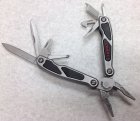john lucas
AAW Forum Expert
Before I moved I was doing some task repeatedly and decided it was time to make a tool to make it more efficient. So I made the tool. Now almost a year later I have no earthly idea why I made it. Anyone have any guesses. I do have dovetail jaws and thought it might be for doing rebates but then why would I make the grinds on the right hand side.



